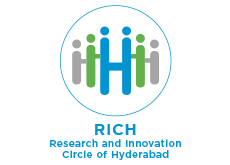
Revolutionising Blood Sugar Monitoring: It All Started With an Idea
How do you convert an idea into a reality? You have conviction in its success.
This is the conviction that enabled Duvvuru Varshitha Reddy, co-founder of the MedTech start-up VivaLyf Innovations, to get selected into RICH–Acceleration in Diagnostics (AID) Cohort 2. And this is the conviction with which she began her journey of entrepreneurship.
“I had an idea for a non-invasive glucometer,” she says. “And I believed that idea could change the way millions of diabetics live.” Varshitha is a diabetic herself and has been so for her whole life. As a diabetic, she must monitor her blood glucose levels several times a day. “Being a diabetic child is not that easy. You can’t prick yourself wherever you go. There could be people with a fear of blood. And getting people to understand the challenges you face as a diabetic can be hard,” Varshitha says.
Today, with advanced technology such as a one-prick glucometer, semi-invasive skin patches, or wearable sweat analysers, it has become much easier for diabetics to monitor their blood sugar, than to have to go into a pathology lab every time. Yet, the frequency of monitoring can make the process painful and costly, and lower quality of life. “This is why I got into biotechnology, to find a solution to this problem,” Varshitha says.
Despite being a biotechnologist, Varshitha had an innovator’s mindset. That led her to participate in the Smart India Hackathon in 2019, where she became a finalist. At the hackathon, she met Vimal Kumar, now co-founder of VivaLyf Innovations. “I had the idea, but I didn’t have a proper team to develop it,” Varshitha says. “I needed someone from an electronics and electricals background to bring the product into the world. Vimal had this background. So, three months post the hackathon, I called him and said ‘I have an idea. Would you like to listen to it?’ That’s how VivaLyf was born.”
Varshitha and Vimal’s hard work to create the product paid off when, in 2021, the uniqueness of how their product—called Ezlyf—worked earned them a place in RICH–AID Cohort 2.
To use Ezlyf, one simply needs to place their finger on a sensor. Through spectroscopic techniques and machine learning, the device then predicts the blood glucose levels in the body. The results appear on a smart phone app linked to the device. It is completely non-invasive.
But there is much more to the device than ease of use. “It is cost-effective as it eliminates the need for strips or patches every month. Anyone can use it anywhere and the app stores all the reports automatically,” Varshitha says. “The app also sends reminders to test at regular intervals and suggests ways to balance sugar levels. What’s more, the app is available in several regional languages and multiple users can simultaneously log in through a single subscription!"
Now, as a member of RICH–AID Coho rt 2, VivaLyf is receiving mentorship—on regulatory requirements, clinical trials, and product launch necessities—and help connecting with various stakeholders such as diagnostic centres and hospitals. Such extensive assistance is exactly what Varshitha and Vimal needed to take their product to the next level.
At the time of writing this story, Varshitha and Vimal await the results of pre-clinical trials for their product. But despite the pending field validations, they have not lost the conviction they’ve always had in its success. “I know that we have developed my idea into an impactful innovation,” Varshitha says. “Once Ezlyf goes to market, it will create a revolution in blood glucose monitoring, and will ease the lives of many who live with diabetes.”
From RICH, we too wish VivaLyf Innovations great success.


